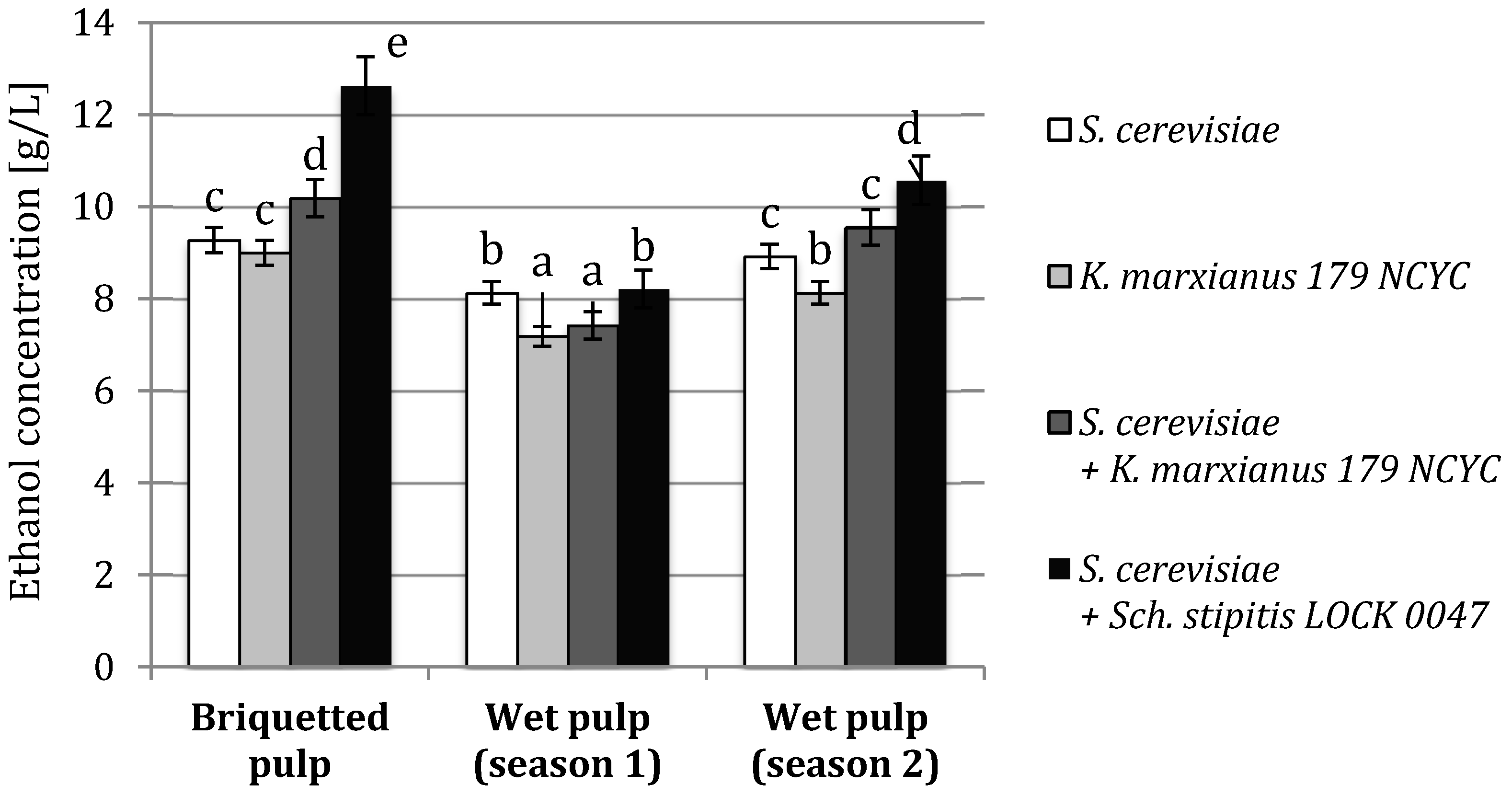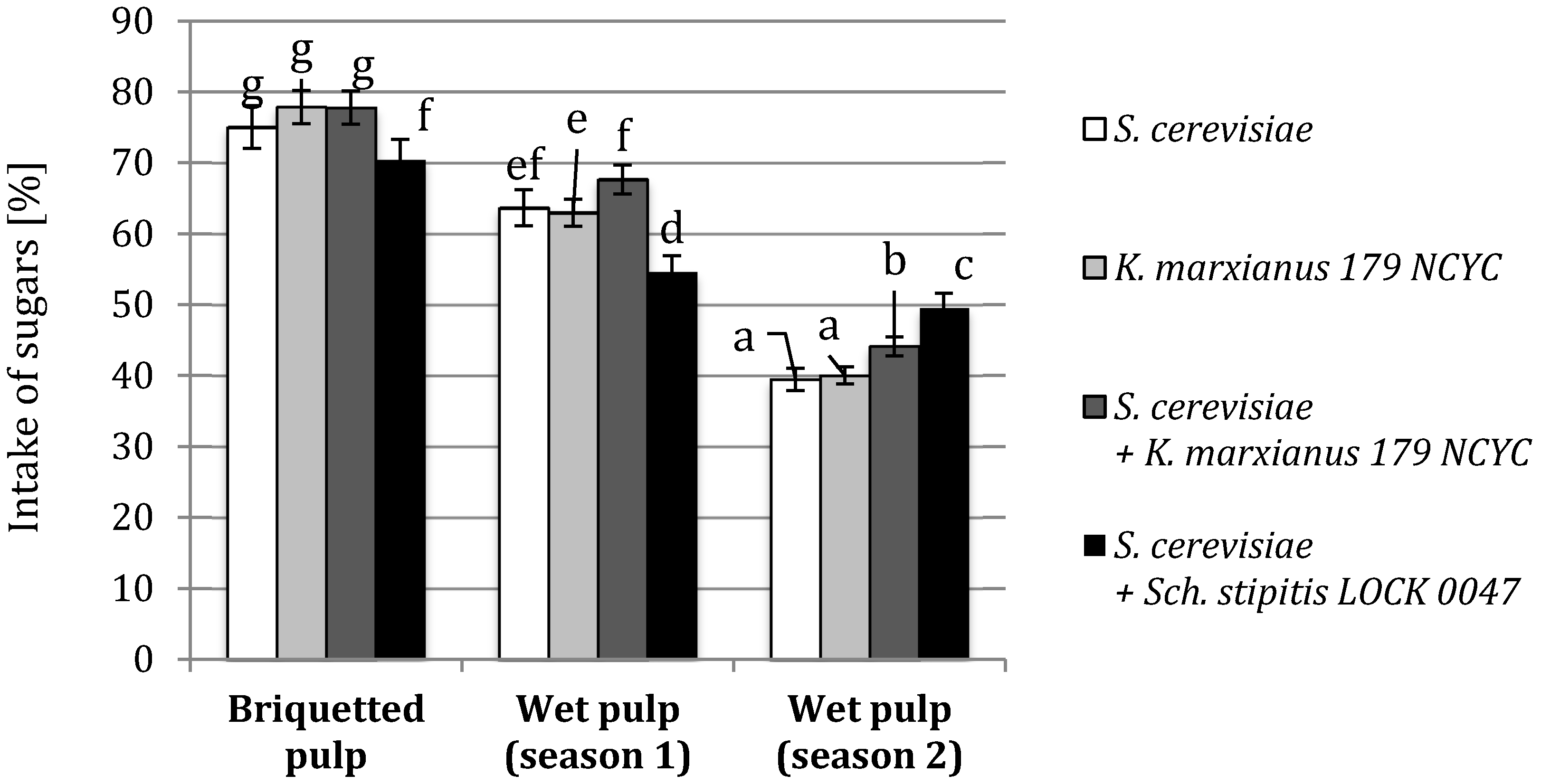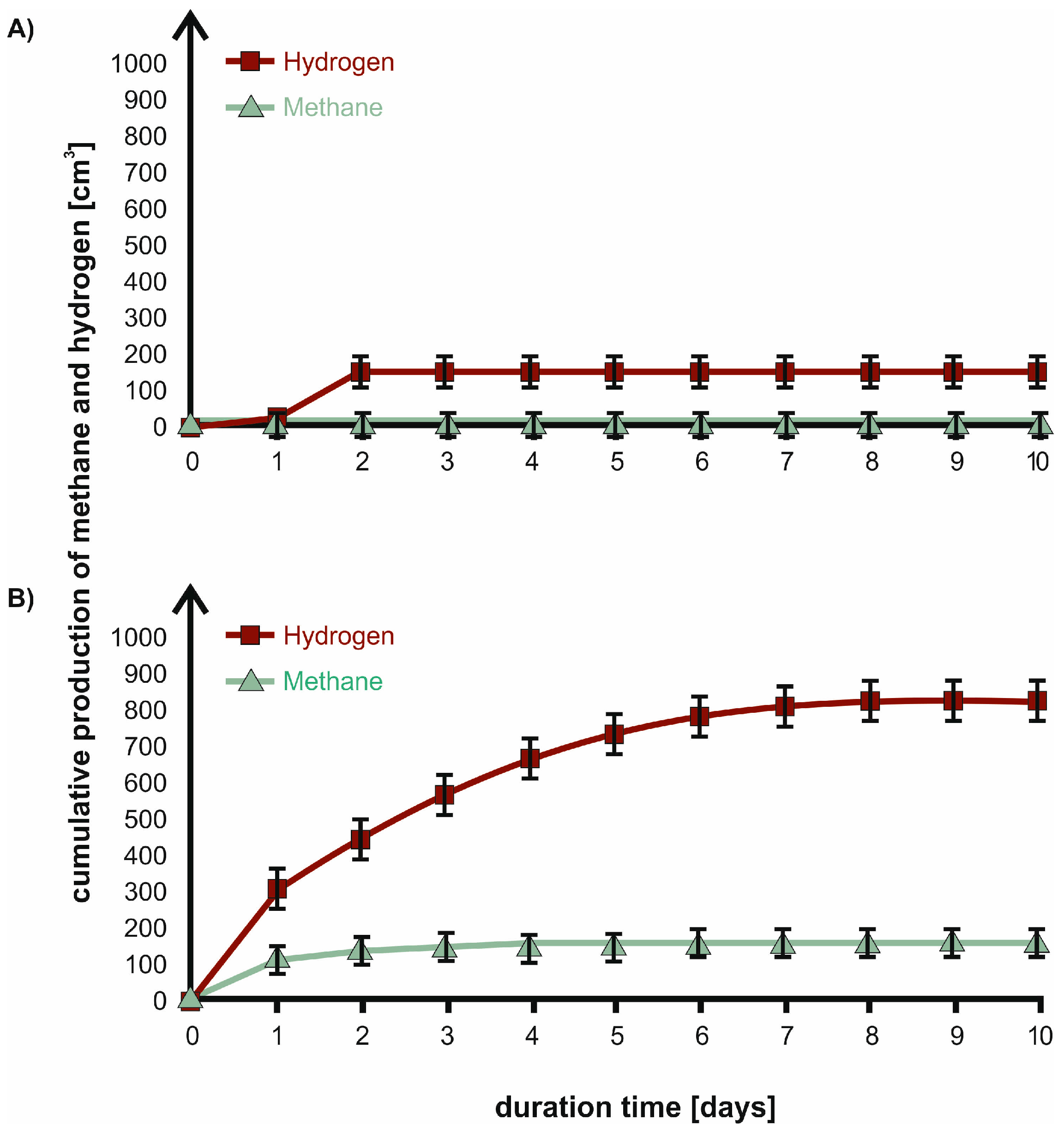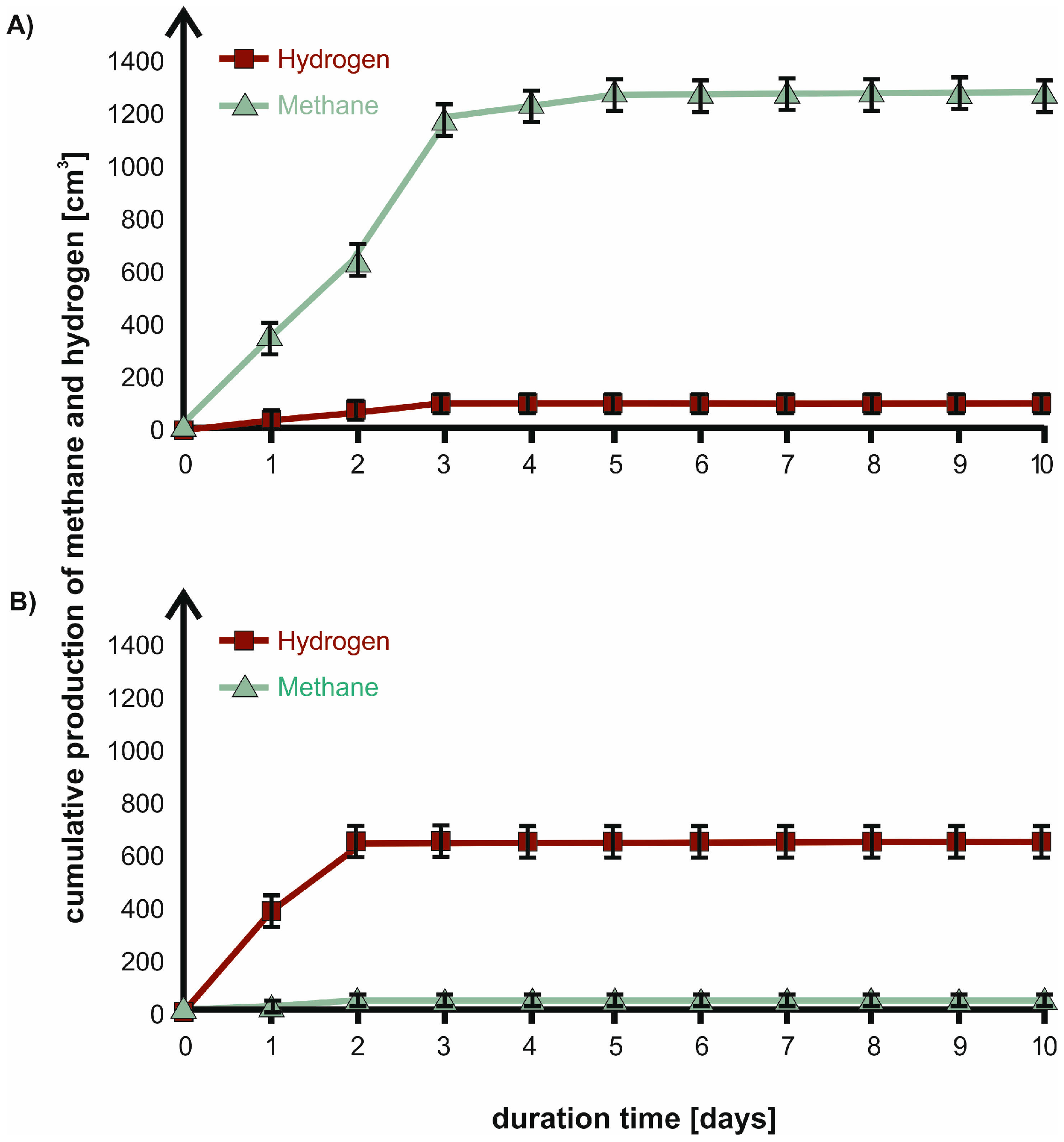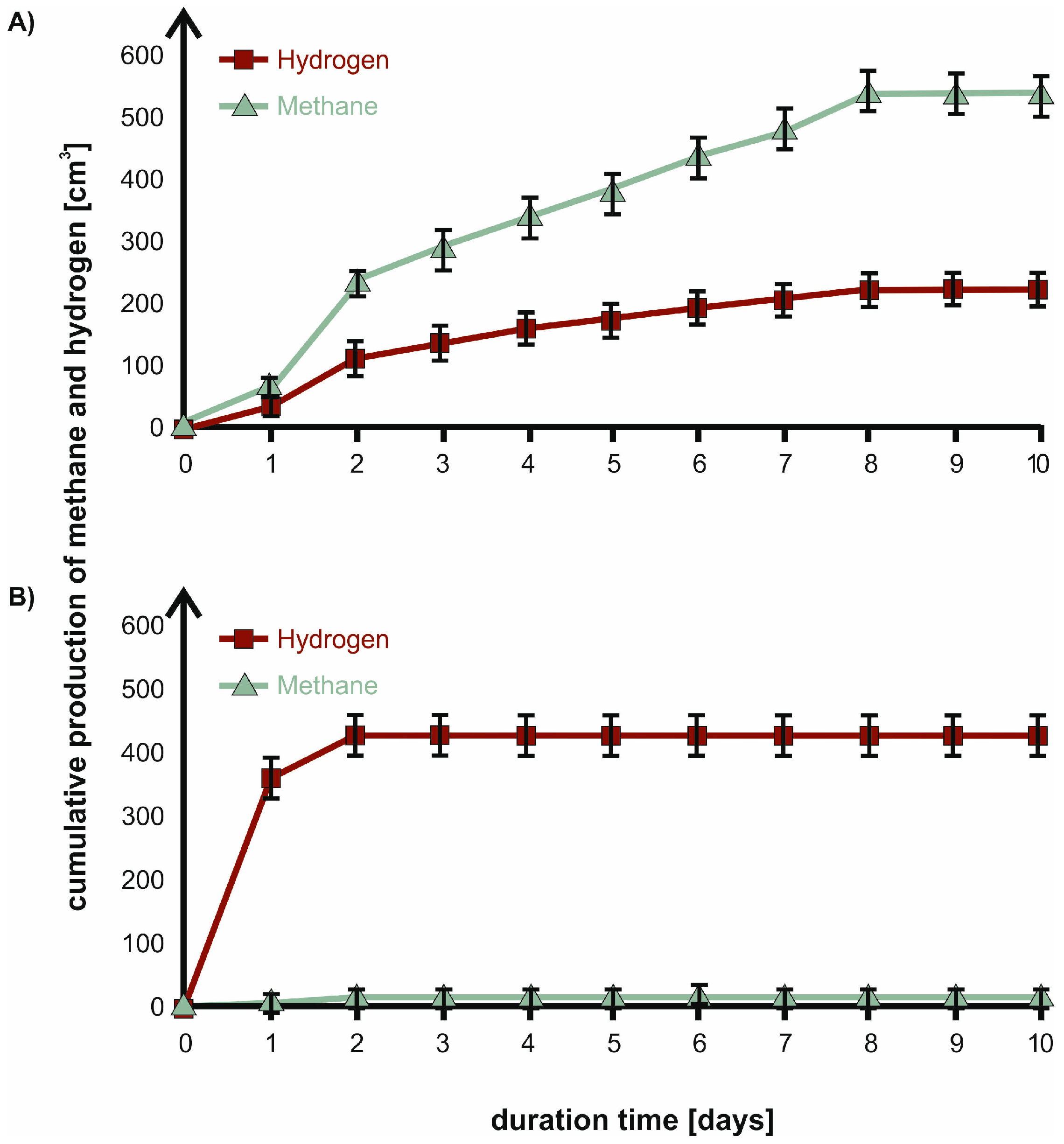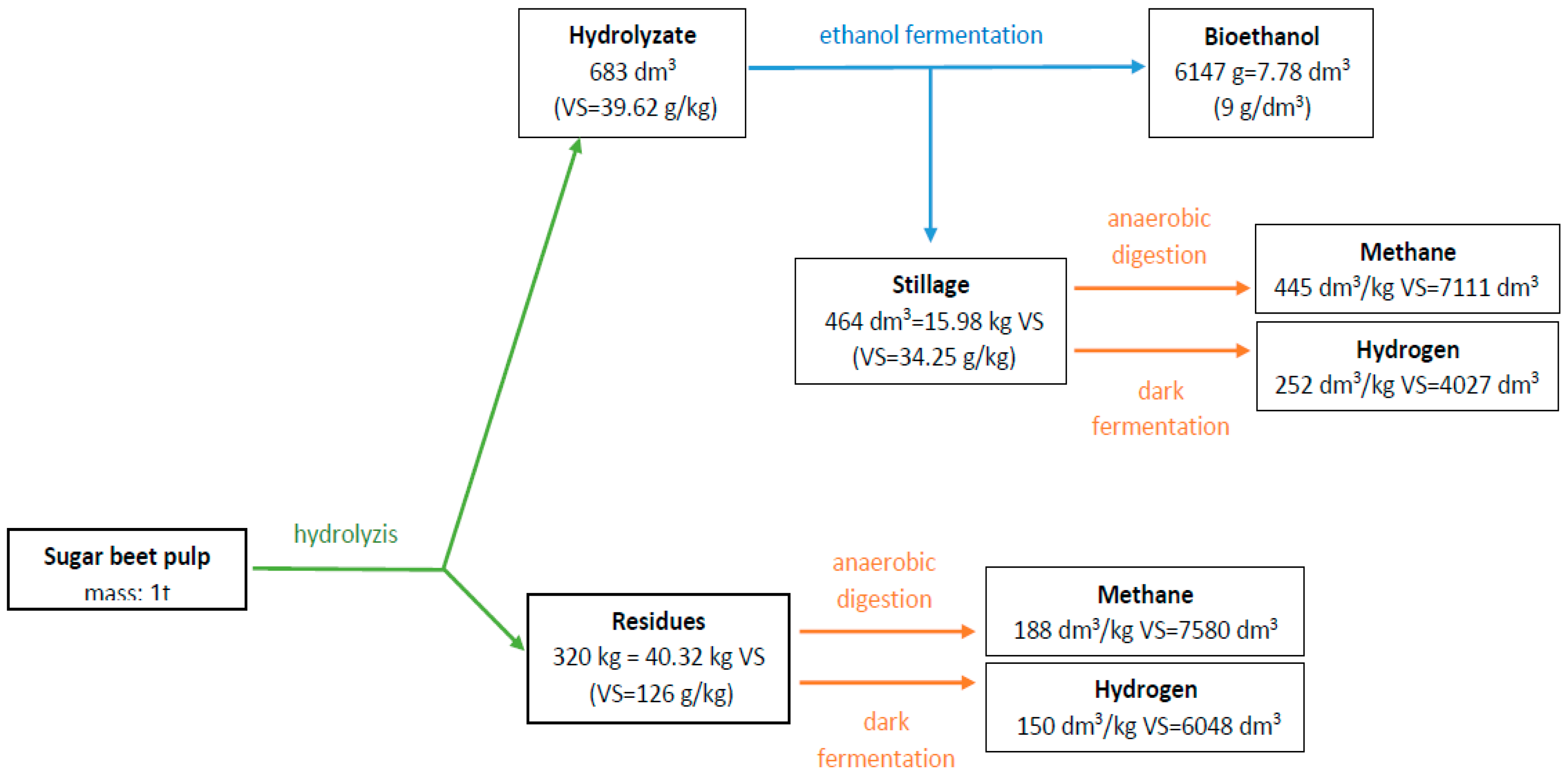2.2.1. Selection of Strains Suitable for Fermentation of Hydrolyzates
Effective utilization of sugar beet pulp biomass-derived media presents several challenges. These relate mainly to the specific composition of the carbohydrates and to the fermentation abilities of used microoganisms [
3,
21,
24]. In our study yeast were chosen for use in further experiments based on their assimilation and fermentation abilities (
Table 3). Hydrolyzates of celluloses and hemicelluloses consist mainly of monomeric hexoses and pentoses. The glucose and xylose released can be fermented by
S. cerevisiae and
Sch. stipitis, respectively [
25]. In our study, as well as the widely-used
S. cerevisiae strain, five unconventional yeast strains were tested for their potential to utilize pentoses. Wild-type strains of
S. cerevisiae are unable to utilize xylose. However, it has been reported that several genetically-modified
S. cerevisiae strains ferment xylose, synthesizing ethanol. Native yeast species able to ferment xylose include Scheffersomyces and Candida species, as well as some strains of
K. marxianus [
26]. Due to its natural ability to assimilate pentose and hexose sugars,
K. marxianus could provide an alternative option to conventional yeasts for second-generation ethanol fermentation [
27]. The metabolic diversity of their various strains makes these species interesting for several potential applications [
28].
The metabolic abilities of the yeast strains were determined based on the profiles of saccharide monomers released from the beet pulp. All of the tested strains utilized glucose, galactose, and mannose for biomass proliferation. CO
2 production was observed mainly for
K. marxianus 179 NCYC and
S. cerevisiae (
Table 3). Arabinose was assimilated by four of the tested strains, but only
Sch. stipitis LOCK 0047 was able to ferment this carbon source, metabolizing xylose for this purpose. These strains were therefore selected for use in further experiments.
2.2.2. Ethanol Fermentation of Sugar Beet Pulp-Based Hydrolyzates
In the next stage of the investigation, the fermentation abilities of the selected yeast strains were verified in the actual media, i.e., in sugar beet pulp-based hydrolyzates. Fermentation of the prepared media was conducted using the commercial yeast
S. cerevisiae and other yeast species, i.e.,
K. marxianus and
Sch. stipitis. The yeast strain
S. cerevisiae, commonly used in the distilling industry, is recommended for the fermentation of hexose sugars (including glucose) in hydrolyzates from starchy raw materials. According to the literature [
29,
30,
31,
32],
K. marxianus is able to utilize various substrates, such as xylose, arabinose, cellobiose, glycerol, xylitol, lactose, and inulin. This is an advantage for the conversion of feedstock containing mixed carbon sources. Moreover,
K. marxianus is able to utilize pentose and hexose sugars for cell biomass generation, fermenting glucose to ethanol, and pentose to xylitol [
33].
Sch. stipitis reveal the ability to ferment many sugars, such as glucose, galactose, mannose, xylose, and cellobiose, along with mannan and xylan oligomers [
34]. Despite the fact, that a large number of yeast species can metabolize xylose, only 1% of strains ferment xylose to ethanol [
35]. It is important to find the most efficient yeast species for the alcoholic fermentation of pentose sugars, including xylose, the main hemicellulosic sugar. Thus,
Sch. stipitis is an attractive option for use in ethanol production from hemicellulose.
As shown in
Figure 1, the highest production of ethanol was observed media fermented with
S. cerevisiae and
Sch. stipitis yeast strains, especially in briquetted sugar beet pulp-based hydrolyzates (12.6 g/L). Fermentation using single cultures of
S. cerevisiae distillery yeast and
K. marxianus NCYC179, as well as mixed cultures of these yeast strains (applied sequentially), resulted in lower yields of ethanol (
p < 0.05).
The highest ethanol yields were produced from briquetted pulp (see
Figure 1), and as a consequence of the intake of sugars during the alcoholic fermentation was also highest for these worts (see
Figure 2). The lowest intake of sugars was observed in fermentation trials from wet pulp (season 2), although ethanol concentrations in these hydrolyzates were higher than in the trials with wet pulp (season 1). This can be explained by the fact that the hydrolyzates from wet pulp (season 2) contained significantly higher (
p < 0.05) concentrations of fermenting hexoses (i.e., glucose and galactose) and pentoses (i.e., arabinose and xylose) than the hydrolyzates of either briquetted pulp or wet pulp (season 1) (see
Table 2).
A high content of fermenting sugars is advantageous from a technological point of view, because it helps to provide a high yield of ethanol from the raw material [
36]. However, it requires the use of yeast strains that are resistant to the multiple stresses affecting the process, including ethanol stress and the osmotic stress that results from high sugar concentrations [
37,
38]. Moreover, yeast cells have specific growth requirements, leading to imbalances or limitations which can result in incomplete fermentation. These requirements include specific amounts of nitrogen, carbon, vitamins, oxygen, and metal ions [
39]. In view of these facts, it may be supposed that higher intakes of sugars than those attained in our experiments could be achieved from the tested hydrolyzates using complex nutrients for yeasts.
Ethanol production from hexoses such as glucose is a well-established industrial process. However, using pentoses such as xylose still presents some challenges [
25]. Unconventional strains such as
K. marxianus possess the useful potential to assimilate a wide variety of substrates, although difficulties may arise.
K. marxianus has been tested for growth on a number of substrates, including xylose. Cultured in an oxygen-limited environment, five environmental isolates of
K. marxianus showed the ability to consume xylose and produce ethanol [
26].
K. marxianus can present different characteristics in terms of galactose utilization. Some studies have shown that ethanol production in media containing galactose was not as high as when glucose was the carbon source, while other research found galactose to be a better carbon source than glucose for ethanol production [
28].
The carbohydrate utilization profiles of the tested yeast strains after fermentation of sugar beet pulp hydrolyzates (see
Table 4) revealed that hexose sugars (i.e., glucose and mannose) were consumed in the largest amounts (78–100%) by all the tested yeast strains, including monocultures and co-cultures. Relatively low utilization was observed in the case of fructose. The addition of monocultures and co-cultures of
S. cerevisiae and
K. marxianus caused utilization of fructose, ranging widely from 17–46%, whereas fermentation with
S. cerevisiae and
Sch. stipitis resulted in full (100%) consumption of this sugar. It can be supposed that the
Sch. stipitis yeast strain is able to consume fructose effectively, but it is not known whether this monosaccharide is metabolized exclusively to ethanol or to other products. Carbon catabolite repression usually takes place in media containing various sugars [
40]. A potential solution to this important problem may be to ferment the hydrolyzates using mixed complementary cultures of conventional and unconventional strains. In parallel hexose and pentose sugar utilization, the lower utilization of pentoses by pentose-fermenting yeast strains presents a major problem. These strains prefer glucose over xylose as a source of carbon, and use glucose in the initial phase of fermentation [
5]. For these reasons, we inoculated the fermentation medium with the pentose-fermenting strain after 24 h, once most of the hexoses had been utilized. Mixed populations generally showed the potential to utilize a broader spectrum of the sugars released from the beet pulp than the yeast monocultures (see
Table 4). Especially in the case of galactose, but also in the cases of arabinose, xylose, rhamnose, and galacturonic acid, the intakes were highest in fermentation trials using
S. cerevisiae and
Sch. stipitis co-cultures.
Using mixed cultures of complementary strains for utilizing carbon sources, as well as the controlled inoculation of S. cerevisiae and non-Saccharomyces yeasts represents a feasible way of improving the complexity and productivity of fermentation processes. S. cerevisiae is known to be rather ineffective at fermenting lignocellulosic hydrolyzates. However, other yeasts assimilate a broader spectrum of carbon compounds. Yeast strains belonging to Pichia (Schefersomyces) genera could also be used in co-cultures with conventional yeasts.
Fermentation of sugars other than glucose (galactose, mannose, arabinose, xylose) has been reported after inoculation of sugar beet hydrolyzate (SBH) with
Schefersomyces stipitis [
3]. However, compared to
Saccharomyces cerevisiae,
Schefersomyces stipitis is known to be less effective for the production of ethanol.
Schefersomyces stipitis has also been reported to consume 45% of the xylose and 0% of the arabinose content in SBH [
25].
